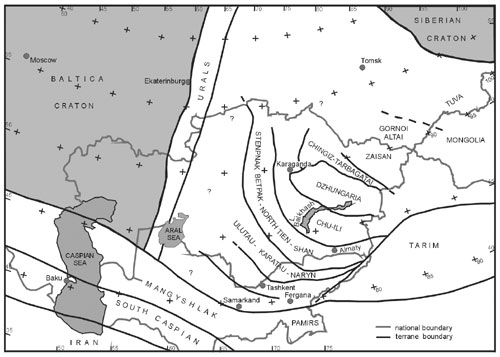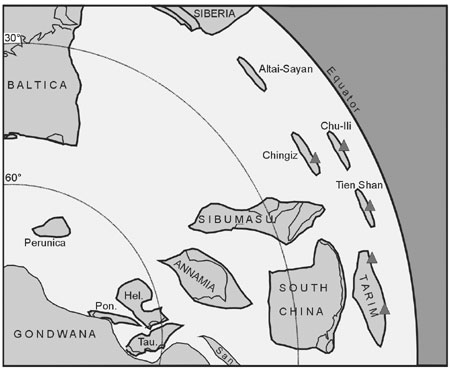
Central Asian terranes and biogeography in the Ordovician
L. Robin M. Cocks1 and Richard A. Fortey1
1 Department of Palaeontology, The Natural History Museum, Cromwell Road, London SW7 5BD, U.K E–mail: r.cocks@nhm.ac.uk / raf@nhm.ac.uk
Key words: Brachiopods. Trilobites. Ordovician biogeography. Kazakhstan. Asia.
Introduction
In today’s geography, Europe (as far east as the Ural Mountains), the old Angaran terrane of Siberia, North China, South China, India, and the Iranian blocks encircle the vast area of central Asia. This includes central Russia, most of Kazakhstan, Uzbekistan, Turkmenistan, Kyrgystan, Tajikistan and the western part of China.
In the southern parts of this region, the Mangyshlak Terrane, Karakum Terrane and Tarim Terrane border the many terranes that made up the northern margin of the supercontinent of Gondwana in Ordovician times. Whether or not the Lut, Sanand and Alborz Terranes of Iran, the Afghan Terrane and the Himalayan terranes of Lhasa and Qiantang actually formed part of Gondwana is uncertain: either they may have been welded to southern Iran and Iraq, Pakistan and India to form integral Gondwana, or one or more of them may have been separate and offshore from the supercontinent. However, the fossils that are known from these last terranes from the late Cambrian and Ordovician indicate clearly that they formed an integral part of the central Gondwanan temperate to subtropical faunal realm (Cocks and Fortey, 1988).
The northern part of central Asia is made up of the Altaids to the west and the Manchurides to the east in a complex melange of terranes which were somewhere between 20 and 40 in number. The work of Sengor and Natalin (e.g.,1996) has been critical in clearly identifying most of the structural boundaries of these terranes. The terranes vary greatly; some have cores as early as Precambrian in age, whilst others are merely the remnants of ephemerally active island arcs or accretionary prisms of various ages through the Palaeozoic (and some in the Manchurides even later).
Some of these central Asian terranes carry few or undiagnostic Ordovician faunas, or have scarcely had their palaeontology investigated. On the other hand, others are well documented, with excellent monographs published on varied, substantial and distinctive faunas. Five such in the latter category are the Tarim, Tien Shan (the term is used loosely here), Chu–Ili, Chingiz–Tarbagatai and Altai Sayan Terranes. Faunas from all of these, described by many authors over a number of years, have been reviewed by us recently (Fortey and Cocks, 2003), and we will now briefly consider them here in turn.
Tarim terrane
From Tarim, Zhou et al. (e.g., 1994) have described diagnostic benthic trilobites, including the raphiophorid Taklamakania and the trinucleid Xuishuililithus, linking the terrane biologically to South China. The Altun region in the east of Tarim is mostly represented by deeper–water facies in the Ordovician, with relatively cosmopolitan faunas, but the East Gondwanan endemic trilobites Pliomerina and Lonchobasilicus, earlier known only from North China, are recorded. In summary, although the unusual abundance of raphiophorids with limited distributions is a distinctive local feature, the overall faunas of Tarim suggests that it was not at a very great distance from East Gondwana in the Ordovician.

Figure 1. Map of Central Asia today, showing the boundaries of the various terranes discussed in the text (from Fortey and Cocks 2003, Figure 13).

Figure 2. Our suggested reconstructions for a segment of the Palaeotethys Ocean during the Caradoc. The major terrane positions are taken from Cocks and Torsvik (2002), but the changed positions of the Altai–Sayan, Chingiz, Chu–Ili, Tien–Shan and Tarim Terranes are taken from Fortey and Cocks (2003, Figure 15). The black triangles are the records of the trilobite Taklamakania.
Tien–Shan terrane
This term is used loosely here, prior to the results of current work being finalised, and includes the Malyi and Bolshoi Karatau Terranes of some previous authors. North Tien–Shan includes Ordovician deposits carrying benthos with genera in common with those from deeper–water deposits of South China, such as the trilobites Charchaqia, Promacropyge, Lophosaukia and Amzasskiella. From limestones overlying volcanic mounds in the adjacent Ulutau–Karatau–Naryn Terrane, Apollonov and Chugaeva (1983) described dikelokephalinids of dominantly East Gondwana type and their Batyraspis is known only also from South China, although there are a number of endemic genera suggesting distancing from other terranes. From the Stepnak–Betpak–North Tien–Shan Terrane Lisogor (1961) has recorded trilobites comparable to the Tremadoc of Wales and South America, including Dichelepyge and Hysterolenus. Once again the overall aspects of the Tien Shan benthic faunas are more akin to Gondwana than elsewhere. There have been suggestions from a few authors that some of the benthos might indicate Baltic affinities, but, on further analysis we think that those records represent cosmopolitan brachiopods and trilobites rather than essentially Baltic ones. In any case, the best documented brachiopods (Holmer et al., 2000) come from the Alai Range of South Tien–Shan, which was included within a terrane separate from both the Ulutau–Karatau–Naryn Terrane and also the Stepnak–Betpak–North Tien–Shan Terrane.
Chu–Ili terrane
This terrane lies north and east of the Tien–Shan Terrane today. The Caradoc brachiopods from the Anderken Formation have been monographed recently by Popov et al., (2002), and are richly diverse, with 62 species among 55 genera. The biogeographic message is mixed; overall the Anderken brachiopods are most similar to a contemporary fauna from North China, but genera such as Mabella, Dulankarella and Teratelasmella are known elsewhere only from the Chingiz Terrane and from the southeast Australian island arcs, and there are seven endemic genera. From the overlying Dulankara Formation, there are distinctive trilobites including Parahawleia, Ovalocephalus and Koksorenus, and brachiopods which again include endemics but also genera such as Phaceloorthis and Dulankarella, which suggest further links with China and the Australian part of East Gondwana.
Chingiz–Tarbagatai terrane
Northeastern Kazakhstan includes a large, and possibly composite, terrane dominated by volcanics and clastics in the Chingiz and Tarbagatai mountain ranges. In the late Llanvirn Bestamak Formation of Chingiz the distinctive raphiophorid trilobite Taklamakania is again found, together with Manykaia, Birmanites and Selenopeltis, among others, which are Chinese in character. The associated brachiopods (Klenina et al., 1984), including several endemics and relatively widespread genera, but Shlyginia, Kajnaria and Esilia are known elsewhere from only the Tien–Shan and Chu–Ili terranes. Other brachiopods from that and the overlying Caradoc Taldyboy Formation provide faunal links with New South Wales. Once again, the faunas link this terrane to peri–Gondwana, including South China, in middle to late Ordovician time.
Altai–Sayan terrane
The Gornyi Altai region has had its Ordovician and Silurian brachiopods well monographed (e.g., Kulkov and Severgina 1989). From the Tremadoc Tayanzin Formation and the succeeding Arenig Lebed Formation and Llanvirn Rydinkov Formation, Laurentian and Siberian–affinity brachiopods are known, as well as a succession of endemic genera at each of those horizons, suggesting that the terrane was not close to any of the adjacent large palaeocontinents. However, from Caradoc times onwards, the peri–Gondwanan signal is strong through the trilobites Neseuretinus, Prionoceilus, Vietnamia, Calymenia and others. They are accompanied by more than 30 brachiopod genera in the Caradoc Khankarin Formation, which together indicate a progressive nearing of this terrane to other low–latitude continents.
Conclusions
Some previous authors, notably Sengor and Natalin (1996), have asserted that the Kazakh terranes described above, in addition to many others, formed integral parts of an extensive Kipchak Arc, which lay between Baltica and Siberia in the Lower Palaeozoic. However, our analysis of the Ordovician trilobites and brachiopods from these terranes suggest that this was not the case, and they probably formed independent terranes within the Palaeotethys Ocean during that time. Tarim, Tien–Shan, Chu–Ili and Chingiz–Tarbagatai were all not so far from the eastern and tropical parts of Gondwana itself, as was also the South China Terrane. Altai–Sayan appears to have been more distant from Gondwana in the Early Ordovician, but appears to have drawn closer to it from Caradoc times onwards.
References
Apollonov, M.K. and Chugaeva, M.N. 1983. Some trilobites from the Cambrian–Ordovician boundary interval from Batyrbai, Malyi Karatau. The Lower Palaeozoic Stratigraphy and Palaeontology of Kazakhstan. Kazakh SSSR Publishing House, Alma–Ata: 66–89.
Cocks, L.R.M. and Fortey, R.A. 1988. Lower Palaeozoic facies and faunas around Gondwana. Geological Society, London, Special Publications, 37: 183–200.
Cocks, L.R.M. and Torsvik, T.H. 2002. Earth geography from 500 to 400 million years ago: a faunal and palaeomagnetic review. Journal of the Geological Society, London, 159: 631–644.
Fortey, R.A. and Cocks, L.R.M. 2003. Palaeontological evidence bearing on global Ordovician–Silurian continental reconstructions. Earth Science Reviews, 61: 245–307.
Holmer, L.E., Popov, L.E. and Bassett, M.G. 2000. Early Ordovician organophosphatic brachiopods with Baltoscandian affinities from the Alay Range, southern Kyrgystan. Geologiska Föreningens Förhandlingar, 122: 367–375.
Klenina, L.N., Nikitin, I.F. and Popov, L.E. 1984. Brachiopods and biostratigraphy of the Middle and Upper Ordovician of the Chingiz Ranges. Nauka, Alma–Ata: 196.
Kulkov, N.P. and Severgina, L.G. 1989. Stratigraphy and brachiopods of the Ordovician and Lower Silurian of Gornoi Altai. Trudy Academy of Sciences of USSR Siberian Branch Institute of Geology and Geophysics, 717: 1–223.
Lisogor, K.A. 1961. Trilobites of Tremadoc and adjacent deposits of Kendyktas.Trudy Akademiya Nauk SSSR Geologicheskovo Instituta, 18: 55–92.
Popov, L.E., Cocks, L.R.M. and Nikitin, I.F. 2002. Upper Ordovician brachiopods from the Anderken Formation, Kazakhstan: their ecology and systematics. Bulletin of the Natural History Museum, Geology Series, 58, 13–79.
Sengor, A.M.C. and Natalin, B.A. 1996. Palaeotectonics of Asia: fragments of a synthesis. In Yin, A. and Harrison, T.M. (Eds.), The tectonic evolution of Asia. Cambridge University Press: 486–640.
Zhou, Z.–y., McNamara, K.J., Yuan W.–w. and Zhang, T.–r. 1994. Cyclopygid trilobites from the Ordovician of north–eastern Tarim, Xinjiang, northwest China. Records of the Western Australian Museum, 16: 593–622.
Received: February 15, 2003
Accepted: June 15, 2003